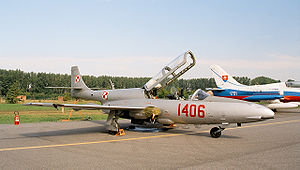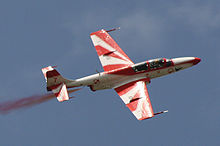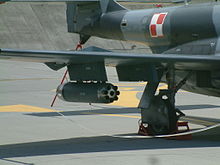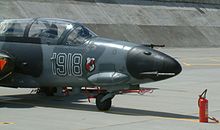- PZL TS-11 Iskra
-
TS-11 Iskra TS-11 Iskra bis DF at Radom Air Show 2005 Role Trainer aircraft Manufacturer PZL-Mielec First flight 5 February 1960 Introduction 1964 Primary users Polish Air Force
Indian Air ForceProduced 1963-1987 Number built 424 The PZL TS-11 Iskra (English: Spark) is a Polish jet trainer aircraft, used by the air forces of Poland and India. It is notable as the main trainer plane of the Polish Army, the oldest jet plane still in service in Poland - and one of the most reliable.
Contents
Development
The aircraft was designed in response to a Polish Air Force requirement for a jet trainer. The main designer was Tadeusz Sołtyk - hence a designation letters TS. The new plane was the first jet aircraft designed in Poland. Work started in 1957, the first prototype powered by an imported British Armstrong Siddeley Viper 8 of 7.80 kN (1,750 lbf) was flown on February 5, 1960. The next two prototypes, with a Polish copy of the Viper engine named the WSK HO-10 engine were flown in March and July 1961.
The new plane fulfilled requirements and, after tests, was accepted for the Polish Air Force as the TS-11 Iskra bis A, produced since 1963. From about 1966, the aircraft were produced with a new Polish-designed engine WSK SO-1 with thrust of 9.80 kN (2,200 lbf). From 1969, WSK SO-3 engines with longer time between overhauls were used and later improved version WSK SO-3W with thrust of 10.80 kN (2,425 lbf).
Design
All-metal jet trainer plane, conventional in layout, with mid-wings. Wings are trapezoid-shaped, with leading edge swept at small angle. Air intakes in wings. Single jet engine has an exhaust under a boom with tail fin, which gives the plane an unusual silhouette. The two crewmen have ejector seats. The aircraft has no radar (apart from the TS-11R). It can be fitted with photo cameras.
Poland is currently developing the new TS-11S Iskra (Spark) for future jet trainer. It will be equipped with new avionics, strengthened structures and a more powerful engine.
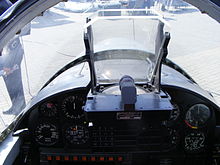 HUD mounted in PZL TS-11F Iskra (MSPO 2008).
HUD mounted in PZL TS-11F Iskra (MSPO 2008).
Operational history
TS-11 Iskra MR of Biało-Czerwone Iskry aerobatic team
In 1964, the TS-11 prototype beat four world records in its class, among others the speed record of 839 km/h (524 mph). The Iskra competed as the standard jet trainer for the Warsaw Pact, but due to a political decision[citation needed], the Czechoslovakian Aero L-29 Delfin was chosen. Poland became the only Warsaw Pact country using the Iskra. 424 aircraft were built by 1987, when production ceased. 50 aircraft Iskra bis D were exported to India in 1975, then further 26 in the 1990s.
In 2002, Poland still had 110 TS-11s, including 5 TS-11Rs. The Iskra became Polish first and only jet trainer so far - the programme for a successor, the PZL I-22 Iryda (later designated M-93 Iryda), failed for several reasons and few were built. In Indian service, Iskra was withdrawn by December 16, 2004 (during service 7 were lost, killing 4 crew).
In 2011, Poland had less than 79 ( total number of school airplanes - TS-11, PZL-130) operational Iskras' according to official data.[1]
From 1969 TS-11s have been used by the Polish aerobatics team, initially called "Rombik", and currently "Biało-Czerwone Iskry" ("White-and-Red Iskras").
Variants
- TS-11 Iskra bis A
- Two-seat jet trainer aircraft. The Iskra bis A was the first production model.
- TS-11 Iskra bis B / TS-11 Iskra 100
- Two-seat jet trainer aircraft, with four underwing pylons to carry weapons.
- TS-11 Iskra bis C / TS-11 Iskra 200 Art
- Single-seat reconnaissance plane from 1971. It had a camera in the lower fuselage and increased fuel capacity. Only 5 were built in 1972, in 1983 were converted to trainers.
- TS-11 Iskra bis D / TS-11 Iskra 200 SB
- Two-seat jet trainer aircraft from 1973. Fifty of those aircraft were built for the Indian Air Force with bigger payload.
- TS-11 Iskra bis DF
- Two-seat trainer-reconnaissance plane from 1974. It can carry armament, plus three cameras.
- TS-11 Iskra R
- Two-seat naval reconnaissance plane, equipped with a surveillance radar, RDS-81. Six aircraft converted in 1991.
- TS-11 Iskra BR 200
- Single-seat attack and reconnaissance plane prototype from 1972, did not enter production.
- TS-11 Iskra MR
- TS-11 with modernized avionics according to ICAO standards and operated in the Biało-Czerwone Iskry aerobatics team since 1998.
- TS-11 Iskra Jet / TS-11 Spark
- After being withdrawn from service, it was disarmed and sold to private users in the USA, Australia and others countries as a warbird valued for its double seats and easy handling.
- TS-11F Iskra
- Proposition of modernisation of TS-11 made by Instytut Techniczny Wojsk Lotniczych, as training jet preparing pilots to operate on F-16 C/D Block 52+[2]
Operators
 TS-11 Iskra MR of Biało-Czerwone Iskry team
TS-11 Iskra MR of Biało-Czerwone Iskry team
- Indian Air Force received 76 aircraft. All were withdrawn by Dec 2004.[3]
- Polish Air Force
- Polish Navy - Former operator.
Specifications (Iskra bis D)
Data from Jane's All The World's Aircraft 1976-77 [4]
General characteristics
- Crew: Two - student and instructor
- Length: 11.15 m (36 ft 7 in)
- Wingspan: 10.06 m (33 ft 0 in)
- Height: 3.50 m (11 ft 5½ in)
- Wing area: 17.5 m² (188 ft²)
- Empty weight: 2,560 kg (5,644 lb)
- Loaded weight: 3,734 kg[5] (8,215 lb)
- Max takeoff weight: 3,840 kg (8,470 lb)
- Powerplant: 1 × WSK SO-3 turbojet, 9.81 kN (2,205 lbf)
Performance
- Never exceed speed: 750 km/h (Mach 0.8, 404 knots, 466 mph)
- Maximum speed: 720 km/h (388 knots, 447 mph) at 5,000 m (16,400 ft)
- Cruise speed: 600 km/h (324 knots, 373 mph)
- Stall speed: 140 km/h (92 knots, 106 mph) (power off, flaps down)
- Range: 1,250 km (673 nmi, 776 mi)
- Service ceiling: 11,000 m (36,000 ft)
- Rate of climb: 14.8 m/s (2,913 ft/min)
- Wing loading: 213 kg/m² (43.6 lb/ft²)
- Thrust/weight: 0.30
Armament
- 1x 23 mm NS-23 or NR-23 cannon in the nose
- 4 underwing pylons, up to 400 kg (880 lb) of bombs or unguided S-5 rocket pods Mars-4 (4 rockets) or Zeus-1 gun packs.
See also
- Aircraft of comparable role, configuration and era
- Aermacchi MB-326
- Aero L-29
- Fouga Magister
- Jet Provost
- Soko G-2 Galeb
- TT Pinto
- Yakovlev Yak-30 (1960)
References
- ^ http://mon.gov.pl/pl/strona/206/LG_54_181
- ^ http://docs.google.com/viewer?a=v&q=cache:XGHVgLW8llkJ:www.itwl.pl/en/pdf/iskra_ang.pdf+TS-11F+ITWL&hl=pl&gl=pl&pid=bl&srcid=ADGEESiyj7BIKWiC5Ka3ZKGEk9aOX2zozHp34ZFtfKB6vfgkAfinzw5v6lmmbKvpG5JT-RIZ1WrfgcGNweISdWFD9P2I1XRDvnWv4n8HXwZwJSC4OZpZmOkC3h4NQKoqGb-NzVR9l8CV&sig=AHIEtbSTtTd_2m7EijwPeuOhdmwyBvkSAA
- ^ Indian Iskras Phased Out www.bharat-rakshak.com
- ^ Taylor 1976, pp. 143-144.
- ^ Air International March 1979, p.130.
- "Poland's Veteran Spark". Air International, March 1979, Vol 16 No. 3. Bromley, UK:Fine Scroll Publishing. pp. 126–131.
- Taylor, John W.R. (editor). Jane's All the World's Aircraft 1976-77. London:Macdonald and Jane's, 1976. ISBN 0-354-00538-3.
External links
External links
PZL aircraft PZL - up to 1939
(Państwowe Zakłady Lotnicze)PZL: P.1 · Ł.2 · PZL.3 · PZL.4 · PZL.5 · P.6 · P.7 · P.8 · P.11 · PZL.12 (PZL-H) · PZL.16 · PZL.19 · PZL.23 Karaś · P.24 · PZL.26 · PZL.27 · PZL.30 Żubr · PZL.37 Łoś · PZL.38 Wilk · PZL.39 · PZL.42 · PZL.43 · PZL.44 Wicher · PZL.45 Sokół · PZL.46 Sum · PZL.48 Lampart · PZL.49 Miś · PZL.50 Jastrząb · PZL.53 Jastrząb II · PZL.54 Ryś · PZL.55 · PZL.56 Kania ·
CSS / WSK-Okęcie
/ PZL Warszawa-OkęciePZL: PZL-101 Gawron · PZL-102 Kos · PZL-104 Wilga · PZL-105 Flaming · PZL-106 Kruk · PZL-110 Koliber · PZL-111 Koliber · PZL-112 Junior · PZL-126 Mrówka · PZL-130 Orlik · PZL-230 Skorpion
Other produced: WSK Junak · CSS-10 · CSS-11 · CSS-12 · CSS-13 · PZL Jak-12 · MD-12
WSK-Mielec / WSK PZL-Mielec
/ PZL Mielec (Polskie Zakłady Lotnicze)WSK-Świdnik / WSK PZL-Świdnik / PZL-Świdnik WSK PZL-Krosno KR-03
Szybowcowy Zakład Doświadczalny
/ PZL Bielsko-Biała / Allstar PZL GliderSZD-6 · SZD-7 · SZD-8 · SZD-9 · SZD-10 · SZD-11 · SZD-12 · SZD-13 · SZD-14 · SZD-15 · SZD-16 · SZD-17 · SZD-18 · SZD-20 · SZD-21 · SZD-22 · SZD-23 · SZD-24 · SZD-25 · SZD-26 · SZD-27 · SZD-28 · SZD-29 · SZD-30 · SZD-31 · SZD-32 · SZD-33 · SZD-34 · SZD-35 · SZD-36 · SZD-37 · SZD-38 · SZD-39 · SZD-40 · SZD-41 · SZD-42 · SZD-43 · SZD-45 · SZD-48 · SZD-49 · SZD-50 · SZD-51 · SZD-52 · SZD-54 · SZD-55 · SZD-56 · SZD-59
Lists relating to aviation General Aircraft (manufacturers) · Aircraft engines (manufacturers) · Airlines (defunct) · Airports · Civil authorities · Museums · Registration prefixes · Rotorcraft (manufacturers) · TimelineMilitary Accidents/incidents Records Categories:- Polish military trainer aircraft 1960–1969
- Polish military reconnaissance aircraft 1960–1969
- PZL aircraft
- Science and technology in Poland
Wikimedia Foundation. 2010.

